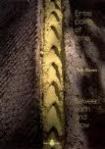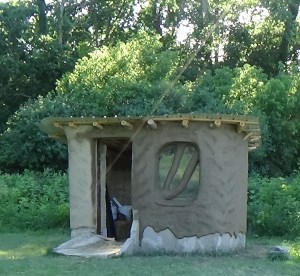 We have been putting tarps over our compost outhouse since we started building it in September 2013. With our focus on the house building this summer, we just wanted to get the outhouse far enough a long so that we could put an earth plaster on the exterior. Assuming it would then be water resistant enough to withstand some rain, our hope was that we would be free of tarps for a while. During the masonry stove build workshop when we could not work on the field-stone stem-wall for the house, we decided to take the opportunity to focus on the outhouse for a while.
We have been putting tarps over our compost outhouse since we started building it in September 2013. With our focus on the house building this summer, we just wanted to get the outhouse far enough a long so that we could put an earth plaster on the exterior. Assuming it would then be water resistant enough to withstand some rain, our hope was that we would be free of tarps for a while. During the masonry stove build workshop when we could not work on the field-stone stem-wall for the house, we decided to take the opportunity to focus on the outhouse for a while.
While Eric and Team Awesome were building the masonry heater, we were cobbing. Fortunately, the next week our friends Michele Curran and Jade Purley arrived just in time to help mix cob and make cob-balls! 
Jade turned out to have mad-cobbing skills. Dancing in the mud came easy to her. Early on she told us, “It’s in my blood!” Jade is from Laguna Pueblo where earth building is an ancient and practiced skill. Michele and Jade helped us with the last push to get the walls built up to the rafters.
Next came the exterior scratch coat of plaster. Like with the rest of this building adventure, we are learning daily by doing and experimenting. We did a small bit of plastering exterior walls during our workshop at Blue Rock Station in 2013, and we observed one of our teachers demonstrating plastering during the Cob Cottage workshop, but until yesterday we had never practiced the technique and recipe we are using for the plastering of our compost outhouse. We figured it is better to do our experimenting on a small project like the outhouse so we know what works (or doesn’t work) in the building of the house.
Our friend Dan Zetah (an experienced straw-bale builder), recommended using fermented liquid in the exterior plaster to make it stronger and more water resistant. We had read about using fermented dung and other materials in a variety of books, but we had no experience with it. With Dan’s endorsement regarding its success, we decided to try it.
Tom Rijven, in his book Between Earth and Straw, explains the importance of the fermentation process. The translation reads: “A natural physical reaction then takes place; the development of bacteria that feed on the glucose in the fibre used for the body coat….These molecules grow longer and bind together a hundred times forming a reinforcement of the body coat.”
We let cut-up apples ferment in the sun and by the time we started pulling out the liquid last Friday, it had the smell of apple-cider vinegar. We added this to chopped straw, grass clippings, sifted clay slip and sand. It all made a creamy plaster that we put on about an inch thick. To get the full benefit of fermentation, we should have let the whole mixture ferment together for another few days–something we didn’t understand from the readings but that was made clear through a conversation with Dan. This demonstrates one of the dangers of book-learning, but it provides another valuable lesson to us as we prepare for the house build. We will monitor how it holds up in the weather and if we need to, we will simply add the final finish coat sooner rather than later.
Waz did most of the body coat application while Scott did most of the troweling and scratching of the surface in preparation for the final finish coat. Once this cures we should be able to forgo the tarps, but with rain in the forecast again this weekend, we decided to tarp again for now until the body coat has had a chance to dry further. We’ll keep monitoring and posting on the hardiness of the new plaster.












